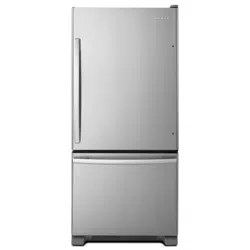Loading ...
Loading ...
Loading ...

7
NOTE: This refrigerator is intended for use in a location where the
temperature ranges from a minimum of 55°F (13°C) to a
maximum of 110°F (43°C). The preferred room temperature range
for optimum performance, which reduces electricity usage and
provides superior cooling, is between 60°F (15°C) and 90°F
(32°C). It is recommended that you do not install the refrigerator
near a heat source, such as an oven or radiator.
Water Supply Requirements
Gather the required tools and parts before starting installation.
Read and follow the instructions provided with any tools listed
here.
Tools Needed:
� Flat-blade screwdriver
� 7/16" and 1/2" Open-end or two
adjustable wrenches
� 1/4" Nut driver
� 1/4" Drill bit
� Cordless drill
IMPORTANT:
� Connect to a potable water supply only.
Do not use with water that is microbiologically unsafe or of
unknown quality without adequate disinfection before or after
the system. Systems certified for cyst reduction may be used
on disinfected waters that may contain filterable cysts.
� All installations must meet local plumbing code requirements.
� Do not use a piercing-type or 3/16 " (4.76 mm) saddle valve
which reduces water flow and clogs more easily.
� Use copper tubing and check for leaks. Install copper tubing
only in areas where the household temperatures will remain
above freezing.
� For models with water filters, the disposable water filter should
be replaced at least every 6 months.
Water Pressure
A cold water supply with water pressure of between 35 psi and
120 psi (241 kPa and 827 kPa) is required to operate the water
dispenser and ice maker. If you have questions about your water
pressure, call a licensed, qualified plumber.
Reverse Osmosis Water Supply
IMPORTANT: The pressure of the water supply coming out of a
reverse osmosis system going to the water inlet valve of the
refrigerator needs to be between 35 psi and 120 psi (241 kPa and
827 kPa).
If a reverse osmosis water filtration system is connected to your
cold water supply, the water pressure to the reverse osmosis
system needs to be a minimum of 40 psi to 60 psi (276 kPa to
414 kPa).
If the water pressure to the reverse osmosis system is less than
40 psi to 60 psi (276 kPa to 414 kPa):
IMPORTANT: Flush the water system before calibrating
Measured Fill. See “Flush the Water System” in the Owner’s
Manual.
If you have questions about your water pressure, call a licensed,
qualified plumber.
Connect the Water Supply
Read all directions before you begin.
IMPORTANT:
� Plumbing shall be installed in accordance with the
International Plumbing Code and any local codes and
ordinances.
� The water tubing on the back of the refrigerator (which is used
to connect to the household water line) is a PEX (cross-linked
polyethylene) tube. Copper and PEX tubing connections from
the household water line to the refrigerator are acceptable, and
will help avoid off-taste or odor in your ice or water. Check for
leaks. If PEX tubing is used instead of copper, we recommend
contacting Service to obtain current part numbers.
� Install tubing only in areas where temperatures will remain
above freezing.
� If you turn on the refrigerator before the water line is
connected, turn off the ice maker to avoid excessive noise or
damage to the water valve.
Connect to Water Line
1. Unplug refrigerator or disconnect power.
2. Turn off main water supply. Turn on nearest faucet long
enough to clear line of water.
3. Find a 1/2" to 1
1
/
4
" (12.7 mm to 31.8 mm) vertical cold water
pipe near the refrigerator.
4. Determine the length of copper tubing you need. Measure
from the connection on the lower right rear of the refrigerator
to the water pipe. Add 7 ft (2.1 m) to allow for cleaning. Use
1/4" (6.35 mm) O.D. (outside diameter) copper or PEX tubing.
Be sure both ends of copper or PEX tubing are cut square.
5. Using a cordless drill, drill a 1/4" (6.35 mm) hole in the cold
water pipe you have selected.
A. Cold water pipe
B. Pipe clamp
C. Copper or PEX
tubing
D. Compression nut
E. Compression sleeve
F. Shutoff valve
G. Packing nut
6. Fasten the shutoff valve to the cold water pipe with the pipe
clamp. Be sure the outlet end is solidly in the 1/4" (6.35 mm)
drilled hole in the water pipe and that the washer is under the
pipe clamp. Tighten the packing nut. Tighten the pipe clamp
screws slowly and evenly so the washer makes a watertight
seal. Do not overtighten.
7. Slip the compression sleeve and compression nut on the
copper tubing as shown. Insert the end of the tubing into the
outlet end squarely as far as it will go. Screw compression nut
onto outlet end with adjustable wrench. Do not overtighten or
you may crush the copper tubing.
Loading ...
Loading ...
Loading ...
